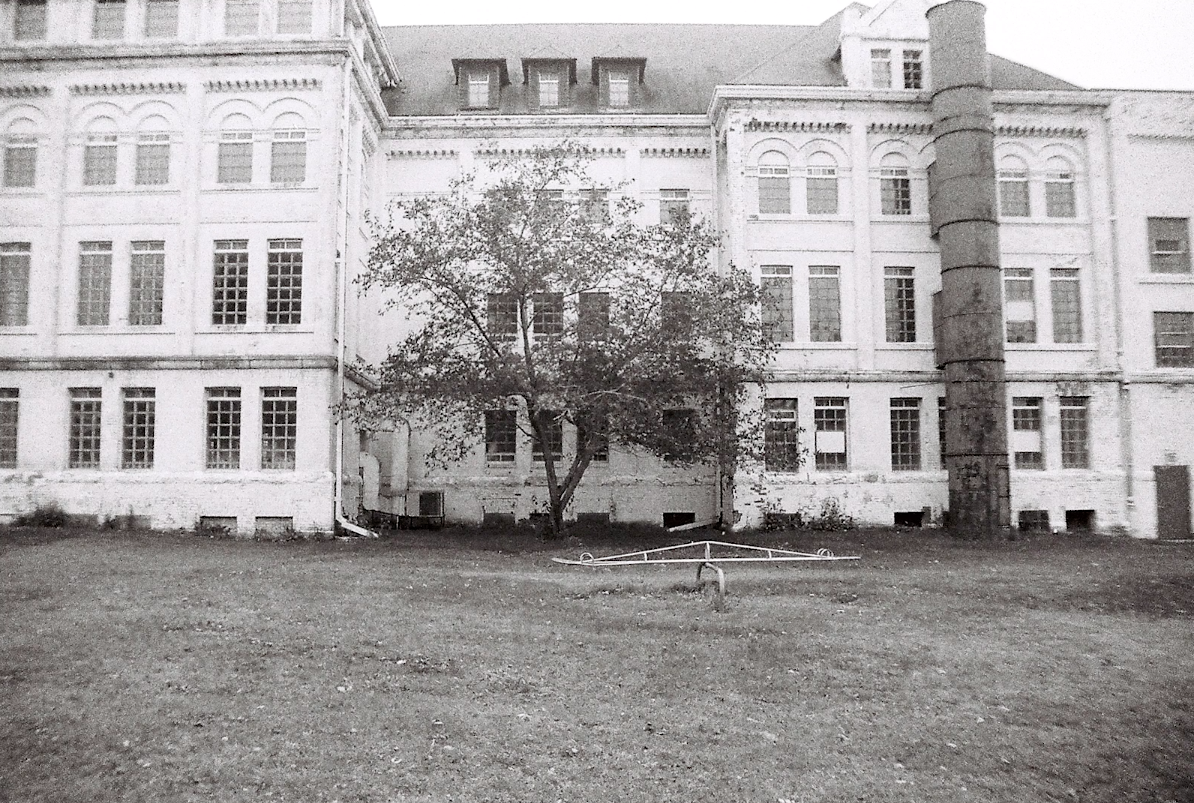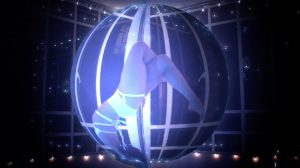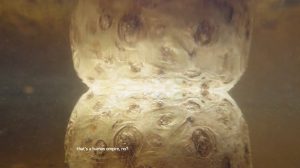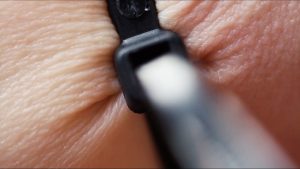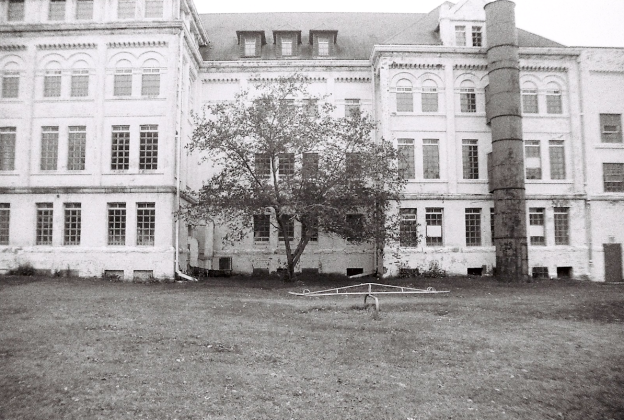
with WHEN WE WENT THERE WE WALKED THE PERIMETER
artwork by KATE HOLFORD
War is the father of all things.
~ Heraclitus
The deafening sound of gunshot shattered an early November morning when my uncle shot himself in the head, leaving my three-year old body splattered with blood. My uncle had brought World War Two home. Like so many others who witness death, destruction, and torture, he returned with a ravished and hyper-aroused nervous system, set on high alert. He suffered from severe combat trauma, and was frequently confused about his whereabouts, seeing the enemy everywhere—including in my mother, and in me. That morning, he saw the enemy in himself.
My mother reacted to the gunshot with rage. She turned on me and beat me, leaving me alone in the house with his body, a dislocated arm, and a broken collar bone. Some time during the next several days, hungry and terrified, searching for my mother, I managed to open the front door, only to find a raging blizzard. When I opened that door the frigid wind and snow blew it open further. A drift of snow kept it ajar, but I was mysteriously kept inside the house, and alive.
Opening the door is the foundation of my life.
A war never occurs in just one place or one life. It ripples out in waves of violence that linger—shadows of the official war—lurking behind closed doors, long after the peace treaties have been signed. That war moved from my uncle’s psyche into mine, through the chambers of my heart, and into the underground trenches of my belly, in the rivers of blood that covered me that day. It slowly and invisibly whittled away at my immune system, my memory, my sense of worth, and even my will to survive, until I tried, just like my uncle, to seek out and kill the enemy in myself. For years, this form of warfare showed up in my life as I threw hand grenades of self-contempt into my already-battered psyche. Like a catechism, I learned and repeated the hateful and degrading messages that were first hurtled at me by my mother—more wounded animal than human. Adding to my arsenal of poor self-esteem were the secrets, secrets too heavy for any child to carry. That shadow war attacked my mother for the rest of her life, leading her into alcoholism and prostitution, and dragging me along with her as a drafted soldier.
Throughout elementary school I was her witness as she worked the strip, picking up men in uniform. Night after endless night, I observed barroom brawls, the exchange of drugs, and the lure of scantily dressed women—all colored in neon lights—outside the gates of the local military bases of my childhood. My mother appeared to be fighting her own war as she used the art of seduction as a weapon, weakening men to conquer them.
We have become a society which has embedded war-thinking and language so deeply within our culture that we don’t recognize how it impacts our daily lives, and even the very systems that claim to promote healing. There is the war on cancer, drugs, poverty, terror, crime, the war against obesity, the war on immigration, and the war on mental illness. Those impacted by any of these wars often find themselves in mental-health treatment. And I did too. I found myself in psychiatric institutions where my experiences converged. What I couldn’t understand was how the very institutions designed for healing became agents of war themselves.
Throughout the late 19th and early 20th centuries, the United States was engaged in the dark practice of eugenics, waging war on its own, those deemed less important. The history of the eugenics movement has impacted psychiatric care and also impacted me, as well as thousands of others, with profound implications for society today. According to Lisa Ko, writing about the history of the eugenics movement, and the use of sterilization: “Eugenics was a commonly accepted means of protecting society from the offspring (and therefore equally suspect) of those individuals deemed inferior or dangerous—the poor, the disabled, the mentally ill, criminals, and people of color.” Eugenics was practiced in the United Kingdom and the United States for many years, and according to German officials, the US inspired the eugenics programs of Nazi Germany, which garnered widespread public outrage following the Nuremberg trials.
It is a matter of public, historical record that in 1927 the Supreme Court ruled that forced sterilization of the handicapped does not violate the US Constitution. Supreme Court Judge Oliver Wendell Holmes stated that “three generations of imbeciles are enough.” In the early 20th century, California began to lead the way, and from 1909-1979 over twenty thousand sterilization procedures were performed. Most sterilizations were conducted without consent, and eventually, thirty-three states would permit and encourage involuntary sterilization.
Stern goes on to tell us as the eugenics movement rose and became widespread in Nazi Germany, the core belief in ‘medicine’ was that all people are not created equal, and some people are not considered human at all. They were known as Untermenschen—subhuman. As Norman Davies writes, this designation referred to non-Aryan, ‘inferior’ people which included Jews, Gypsies, homosexuals, the handicapped, and mentally ill. They were seen and treated as laboratory animals whose bodies were only valuable for research—to advance the goals of the Third Reich. What is less commonly known, is the ways that this same approach to ‘medicine,’ one rooted in eugenics, became part of the American psychiatric system, revealing a troubled ethical core in its inception and early practice.
In Mad in America, Robert Whitaker recounts this shadowy influence in the history of American psychiatry. He writes about the American Eugenics Society (AES) and cites a “137-page booklet called ‘Tomorrow’s Children,’ designed to serve as the society’s ‘catechism,’ schoolchildren and other readers were encouraged to think of the AES as a ‘Society for the Control of Social Cancer.’ The mentally ill and other defectives were an ‘insidious disease,’ and each time they had created children, they created ‘new cancers in the body politic.’”
Several years ago, while conducting research for a mentor, I stumbled upon documents related to a place in Illinois that once held great pain for me, a place in which all patients were treated as ‘less desirables’: Elgin State Hospital. Few people knew anything about that time in my life. I had done therapeutic work to deal with the painful memories of being given a great number of drugs against my will, as well as suffering physical and sexual abuse while incarcerated. I didn’t realize until that moment I had stumbled across something essential to the fullest understanding of my history.
I was institutionalized at Illinois State Psychiatric Institute, soon after beginning college, and then committed to Elgin State Hospital. Given the abuse I suffered there, I would not have survived but for a courageous nurse who fought for my release. In 2015 I was able to locate her, and she told me of the drug research that had been conducted on me and others without our consent. As I began writing my memoir, together we conducted archival research and discovered that Illinois was not the only state to engage in the types of eugenics-based research that I had experienced.
Throughout the Cold War the United States used thousands of vulnerable, unsuspecting citizens as research subjects: newborns, African-Americans, Native Americans, prisoners, our own military. Institutionalized psychiatric patients—both children and adults—would prove to provide easy targets for research. Horrified, I read that psychiatric hospital patients were not only used in this country as research subjects, but they were also routinely abused and neglected, just as I had been—often resulting in premature death. Declassified documents revealed that the United States, in the guise of national security, justified conducting research without informed consent on me, and thousands of others, because we were seen as ‘less desirables,’ albeit American citizens.
Today, I cannot deny my personal history as one of that number, though I tried for many years. A legacy of fear, poverty, and war was woven into my DNA, moving through my bloodstream while still in my mother’s womb. My family’s history followed me and my ravaged mother with the toxic tentacles of ruin and destruction into her subsequent life of prostitution—leaving us both extremely vulnerable. Emotionally and physically malnourished, I was easy prey for other children’s taunts, predatory individuals, and eventually to corrupt practices of governmental and medical research conducted on me, just one member of many in these defenseless populations. Throughout this time in history, I joined classmates in air raid drills, hiding under our desks, instructed to “duck and cover” as an imaginary enemy dropped bombs. Our developing nervous systems ramped up in terror as we were schooled in hate and fear, the hidden psychological weapons of war.
We cannot deny the history of the United States. All of it, even the lesser-known parts, are woven into its DNA and nervous system, lingering in waterways poisoned by toxic waste, dumped by pharmaceutical companies, lingering in dying wildlife, and in changing weather patterns. Ongoing news tells us of ethical violations by pharmaceutical companies, corporations, politicians, medical institutions and practitioners, including those within the fields of psychiatry and psychology. At this time in history our collective shadow is rising to the surface screaming to be seen and acknowledged on both a personal and collective level.
Ultimately, this awareness holds the potential seeds for transformation.
Those seeds were planted deep within me as a child. Looking back, I see how they took root and grew through and despite unimaginable horrors. I survived the impossible and discovered the wellspring where dreams and visions originate, where soul-survival, and thriving, are fed. For years, the shadow of the past muted my life. I searched to make meaning and reached out to a transcendent God. I’ve come to understand my life as a weaving of dark and light. In reviewing my life, I find signs everywhere that, in addition to that transcendent presence, it was as I turned inward and discovered the immanent, indwelling nature of the creator within myself that deep and sustained healing took place.
Despite enormous suffering, I have been granted a profound capacity to experience the beautiful and the sacred. Luminosity and transcendence weave through my history, my spirit nourished through music, sacred places, scriptures, and poetry. The rituals and ceremonies of many religious traditions and various forms of meditation and prayer have fed my soul. The natural world, in the voices of trees, flowers, animals, birds, and insects, has been a source of inspiration and peace. Spirit has come as a quiet but undeniable inner voice of guidance, and through the language of dreams and synchronistic events.
Spirit has appeared in unexpected ways, as angels wearing flesh and human faces—carrying the medicinal quality of compassion and love. By their unexpected presence, they assisted in my survival and ultimate healing. It is in part thanks to them that I can speak with and for those who, like me, have been silenced for decades.
Several years ago, the full realization of their impact hit me in an unexpected way when my professional life took me to the Pine Ridge Reservation in South Dakota. The small group of 6th and 7th grade girls in front of me sat near-mute with despair following the death of a third friend to suicide. I attempted to engage them in relaxation techniques and encouraged them to talk about their emotions. They had barricaded themselves against feelings, and appeared flat, but I could see they were nearly paralyzed in their grief and anxiety.
A girl who I’ll call Stella looked up, studying me, and threw out a challenge, punctuated with a sarcastic, biting cadence to her speech.
“Why are you really here?” The “really” dripping with sarcasm. Although introductions had been offered at the beginning of the group, intuitively, I knew it was something else she sought.
“I care,” I said. “I’ve come with my heart open, in the hopes of bringing my ability to listen, and perhaps some helpful tools.”
She shrugged indifferently.
I repeated some of the themes that had emerged in the other groups of over two hundred young people I had worked with over the course of the week: hopelessness, constant anxiety, isolation, loss of meaning, bullying, abuse, family members who had fallen victim to drug and alcohol addiction, fear of loss of water, fear of the future, and fear that traditional culture would die along with the aging Elder population.
She released a long, drawn-out sigh before looking away, seeming unmoved by my words. My heart and mind stuttered with the realization that it all sounded, well, pretty lame. An inner voice whispered that I had to go deeper and be more real with her. After several seconds I responded.
“When I was your age, I lived in the kind of darkness and loss of hope that I see in your eyes. I tried suicide more than once. I remember what it was like to feel completely hopeless and unable to be with the pain that life threw at me. But there were people who came into my life and held hope for me until I could find it for myself. They held a candle in the light of my darkest despair. If they hadn’t been there for me, I wouldn’t be here today.”
She shrugged and met my gaze with a forcefield of her own hopelessness.
“I don’t believe you. You look too happy. Too peaceful.”
For a second, I wanted to defend myself from the intensity of her despair and disbelief.
“I don’t know if I could have believed what I just said to you back then either,” I told her. “It took me many years to feel the peacefulness and happiness that you see, to escape from the darkness that held me hostage. For a very long time, I never thought I would feel the way I do now or have the life I have.”
She looked away.
It seemed time to move on, and I handed out paper and markers and suggested it might help to draw or write about how they were feeling, if it was too hard to talk about it. They slowly began to draw, and then, to talk about their concerns. Before concluding, I asked each girl to go around and identify one person who they felt they could talk to if they needed support. It became clear that most of them felt isolated, even from each other, though a couple had trusted grandparents they named.
Stella was last. She slowly rolled up her sleeves. With a mixture of fear and defiance, she held out her freshly cut arms. A roadmap of living, oozing flesh revealed her rage, self-hatred, and pain. Her mask fell away as she bit off words of challenge.
“This is who I talk to. I talk to my flesh. I do this to let out the pain. This is why I’m alive. I can at least talk to my flesh.”
I could barely breathe as I looked into her pleading eyes. I inhaled deeply. Very slowly, I rolled up my sleeves and exposed my own scarred flesh. An offering of fifty-plus years of proof that I too had felt that alone and hopeless.
“I talked to my flesh too, when there was no one else. I did this to release the pain and because I hated myself. This is why I am still alive. I could at least do that when no one else would listen to me.”
Suddenly, in a flurry of movement, Stella got up, ran around the table, and threw herself into my arms, sobbing. In that moment as I held this small bundle of heaving misery in my arms, I was grateful for my scars. After she calmed down, I admitted that I had felt very vulnerable showing her my arms. It was the first time I had ever done that—I had always kept them hidden.
“I believe you now,” she said.
And then Stella paused.
“I thought you were just another white bitch who didn’t know anything,” she said shyly.
She’d called me out, daring me to be more authentic, more aware, and to become a better healer. As I looked into Stella’s nearly-smiling face, it became very clear to me that one of my greatest gifts for others is my own history—including my scarred body. That day, in those moments, my history had been transformed into medicine.
Davies, Norman. Europe at War: 1935-1945 No Simple Victory. Macmillan, 2006.
Heraclitus. “Fragment 53.” Fragments of Heraclitus.
Ko, Lisa. “Unwanted Sterilization and Eugenics Programs in the United States.” PBS, 29 Jan. 2016, www.pbs.org/independentlens/blog/unwanted-sterilization-and-eugenics-programs-in-the-united-states.
Stern, Alexander Minna. Eugenic Nation: Faults and Frontiers of Better Breeding in Modern America. University of California, 2005.
United States’ Supreme Court. Buck v. Bell. 2 May 1927. Library of Congress, http://cdn.loc.gov/service/ll/usrep/usrep274/usrep274200/usrep274200.pdf.
Whitaker, Robert. Mad in America: Bad Science, Bad Medicine, and the Enduring Mistreatment of the Mentally Ill. Perseus, 2002.
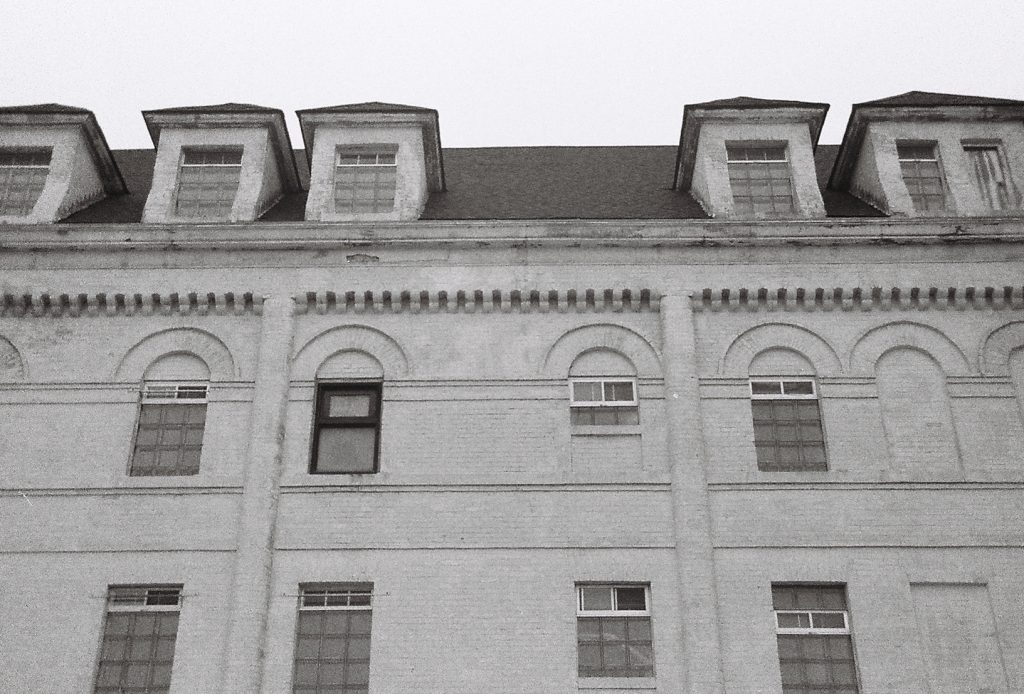
WHEN WE WENT THERE WE WALKED THE PERIMETER (2019) is a speculative piece, using footage and black and white photographs taken at the Kirkbride building in Fergus Falls, Minnesota, in 2018. It forms part of an ongoing collaborative research project with Editor Anne Marie Wirth Cauchon.
LORA MATZ writer
Lora Matz is Clinical Education specialist at PrairieCare psychiatric hospital and clinic system in Minnesota. Lora holds an MS in Clinical Psychology from South Dakota’s Northern State University. For two decades, Lora has acted as a consultant and a senior faculty member at the Center for Mind Body Medicine, where she has conducted workshops and trainings throughout the world. She is known as a powerful storyteller, and is currently writing her memoirs after overcoming abuse, sex trafficking, illegal pharmaceutical drug research, and institutional negligence to become a respected professional in the field of mental health.
KATE HOLFORD artist
Kate Holford is Art Director of Stillpoint Magazine, an artist, and curator based in Glasgow.
© Copyright for all texts published in Stillpoint Magazine are held by the authors thereof, and for all visual artworks by the visual artists thereof, effective from the year of publication. Stillpoint Magazine holds copyright to all additional images, branding, design and supplementary texts across stillpointmag.org as well as in additional social media profiles, digital platforms and print materials. All rights reserved.
